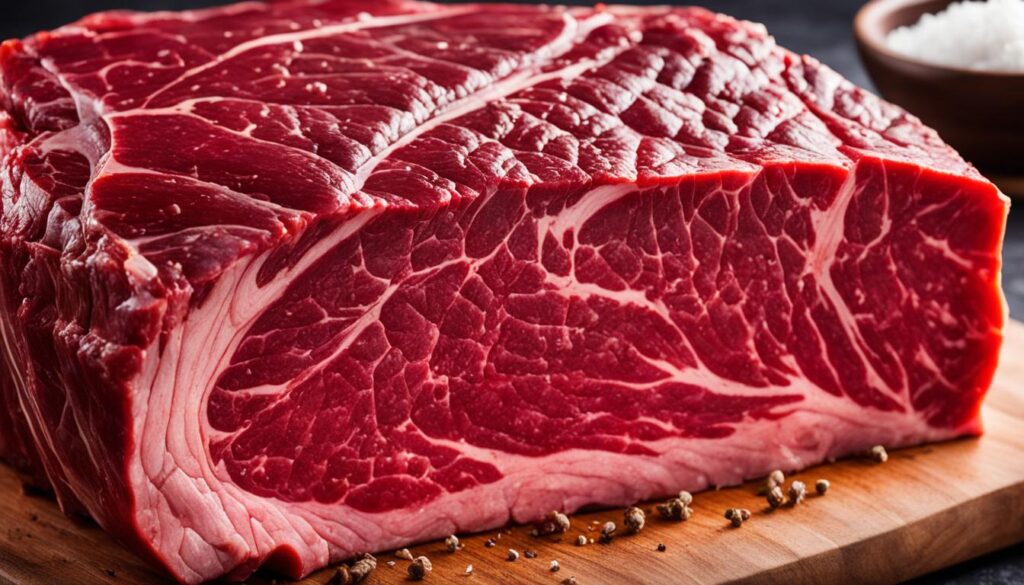Your Guide to Making Biltong at Home
Welcome to your comprehensive guide on how to make biltong at home. In this article, we will walk you through the traditional biltong-making process. Biltong, a popular South African snack, is a delicious, dried meat treat that is perfect for any occasion. Whether you’re a biltong enthusiast or simply looking to try your hand at making your own homemade biltong, we’ve got you covered. So, let’s get started on your biltong-making journey!
Key Takeaways
- Learn how to make biltong at home with our step-by-step guide.
- Choose the right meat for biltong, such as beef or game meats like venison.
- Season your biltong with a spice mixture of sea salt, crushed coriander seeds, black pepper, and paprika.
- Consider marinating the meat in a mixture of vinegar and Worcestershire sauce for extra flavor.
- Hang your biltong in a dry and well-ventilated space or use a biltong box for drying.
- Experiment with different meats, seasonings, and drying methods to create unique biltong flavors.
- Enjoy the satisfaction of slicing into your own homemade biltong and savoring the mouthwatering results.
Choosing the Right Meat for Biltong
When it comes to making delicious biltong, selecting the right meat is key. Beef and game meats like venison are popular choices for biltong recipes. The quality and cut of the meat can significantly impact the flavor and texture of your finished biltong.
For beef biltong, opt for cuts such as silverside or topside. These cuts are lean and well-suited for biltong, ensuring a tender and flavorful result. Before preparing the meat, it’s important to remove any excess fat, as this can affect the drying process. However, leaving some fat on the meat adds extra depth and richness to the flavor.
If you’re feeling adventurous, game meats like venison can be a fantastic alternative. Venison biltong offers a unique and robust flavour profile that complements the traditional biltong seasoning perfectly.
Once you’ve chosen your meat, it’s time to prepare it for the drying process. Cut the meat into strips along the grain, approximately 20cm in length and 1cm thick. This ensures even drying and a satisfying texture in the finished biltong. Additionally, be sure to remove any gristle or sinew, as they can become tough when dried.
Now that you know how to select the perfect meat for your biltong, let’s move on to the essential steps in the biltong-making process.

| Meat Option | Advantages | Disadvantages |
|---|---|---|
| Beef (Silverside or Topside) | Lean and suitable for biltong | May require fat trimming |
| Game meats (Venison) | Unique and robust flavor | Less commonly available |
Essential Steps in Making Biltong
Creating your own biltong requires attention to detail and a few essential steps. From seasoning to drying, each stage contributes to the mouthwatering flavors and textures that make biltong so beloved. Let’s delve into the key processes involved in making this traditional South African delicacy.
1. Seasoning
Seasoning is at the heart of biltong’s rich and savoury taste. To prepare the perfect seasoning mix, combine the following ingredients:
- Sea salt
- Crushed coriander seeds
- Ground black pepper
- Paprika
Thoroughly mix these ingredients to ensure an even distribution of flavours.
2. Marinating
The marinating process infuses the meat with the complex blend of seasonings. Prepare a basting mixture using vinegar and Worcestershire sauce. Coat the meat evenly with this mixture and allow it to marinate for 2-4 hours. This step enhances the flavors and helps tenderize the meat.
3. Coating
After marinating, it’s time to fully coat the meat in the seasoning mix. Ensure that every inch of the meat is covered for maximum flavor. The exact amount of seasoning used may vary depending on personal preference.
4. Drying
The biltong drying process is key to achieving the desired texture and preserving the meat. There are two common methods for drying biltong:
- Biltong Box: Use a specialized biltong box with controlled temperature and humidity settings to dry the meat. This method ensures consistent results and faster drying times.
- Hang Drying: If a biltong box is not available, you can hang the meat in a dry and well-ventilated space. Make sure there is sufficient airflow around the meat to prevent the growth of mould.
The drying process can take anywhere from 24 hours to 10 days, depending on personal preference. Keep an eye on the texture and taste throughout the drying period to achieve the desired level of moisture and tenderness.
By following these essential steps, you’ll be well on your way to creating your own delicious biltong. Experiment with different seasonings and drying times to tailor the flavor to your liking.
Conclusion
Making biltong at home is a rewarding and delicious experience. By following the steps outlined in this guide, you can create your own homemade biltong using traditional South African techniques. Experiment with different meats, seasonings, and drying methods to create your unique biltong flavors.
Creating your own biltong allows you to tailor the flavors to your preferences. Whether you prefer a milder, spicier, or tangier taste, the choice is yours. You can also try using different meats like game meats or even fish to add variety to your biltong repertoire.
The drying process is where the magic of biltong happens. As your biltong dries, the flavors intensify, resulting in a mouthwatering treat. You can choose the drying time to achieve the level of moisture and tenderness that suits your taste.
So why wait? Grab your meat, spices, and biltong box, and embark on a culinary adventure. Let the aroma of your homemade biltong fill your kitchen, and savor the satisfaction of slicing into your own creation. Making biltong at home is not only a delicious way to enjoy a South African delicacy, but it’s also an opportunity to showcase your culinary skills and impress family and friends. Get ready to indulge in the irresistible flavors of your homemade biltong and experience the true essence of South African cuisine.
FAQ
Do I have to use beef to make biltong, or can I use other meats?
While beef is the most common meat used to make biltong, you can also use game meats like venison. The key is to choose lean cuts of meat that are suitable for drying.
What type of beef should I use for making biltong?
Cuts like silverside or topside are ideal for biltong. They are lean and work well for the curing and drying process. It’s also recommended to remove excess fat from the meat, leaving some for additional flavor.
How should I prepare the meat before seasoning it?
Cut the meat into strips along the grain, approximately 20cm in length and 1cm thick. It’s important to remove any gristle or sinew from the meat, as they can become tough when dried.
What spices should I use to season my biltong?
Create a spice mixture using sea salt, crushed coriander seeds, ground black pepper, and paprika. This blend of spices adds flavor to the biltong. Feel free to adjust the quantities based on your taste preferences.
How should I marinate the meat?
Baste the meat with a mixture of vinegar and Worcestershire sauce, and let it marinate for 2-4 hours. This step enhances the flavor and helps tenderize the meat before seasoning.
How should I dry the biltong?
You can dry the biltong using a biltong box or by hanging the meat in a dry and well-ventilated space. The drying process can take anywhere from 24 hours to 10 days, depending on your personal preference for the level of dryness. Monitor the biltong and adjust the drying time accordingly.
How should I store the biltong?
Once the biltong is dried to your liking, slice it according to your preference and store it in a sealable bag or tub. Keep it in a cool, dry place away from direct sunlight. Proper storage helps maintain the flavor and texture of the biltong.
